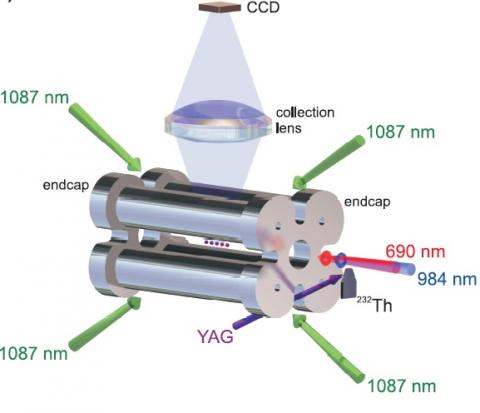

The Atomic, Molecular and Optical physics (AMO) group at Georgia Tech is a strong and diverse group that has made pioneering contributions in the areas of ultracold atomic physics, quantum degenerate gases, quantum optics, quantum information, ultrafast atomic physics, and ultrafast laser metrology.
In the last few decades, advances in laser technology and the invention of laser cooling and trapping techniques for atoms and molecules have opened entirely new, rapidly expanding frontiers of AMO science. These developments have been recognized by 4 recent Nobel prizes: laser-cooling and trapping (1997), Bose-Einstein condensations (2001), optical clocks (2005), and quantum control of ions and cavity QED (2012).
These advances and inventions have provided new tools for investigation of foundational questions in quantum mechanics, studies of atom-light interactions, “table-top” tests of fundamental physics and symmetries (including searches for electric dipole moments, g-2, etc.), and precision metrology of frequency, length, and other important physical quantities. In addition, these advances have led to new areas of research including the investigations of quantum degenerate gases, quantum information and computing, and ultrafast phenomena in atoms and molecules.
Technological applications that derive from work in atomic physics include precision sensors for inertial sensing and navigation, magnetic and electric field sensing, atomic clocks, and emerging quantum technologies — including quantum information processors and quantum communication networks.
Additionally, AMO science contributes to investigations in other areas of physics, including tests of general relativity, fundamental symmetries of the Standard Model, and many-body physics including condensed matter and nuclear physics. Ultra-cold atoms in particular provide new tools to construct quantum simulators to investigate important problems in condensed matter physics, including exotic magnetic order thought to arise in a wide variety of frustrated magnetic materials and unconventional superconductors.
Altogether, these advances have been truly transformative for the field of AMO science and have led to a significant expansion of AMO research programs world-wide. The Georgia Tech group has provided many impactful contributions to the field and enjoys a strong world-wide reputation.
| Name | Research Interests | Research Website |
|---|---|---|
| Michael Chapman |
Contemporary quantum mechanics, manipulating the quantum behavior of single atoms and photons |
Atom Trapping & Quantum Computing Laboratory Website |
| Brian Kennedy |
theoretical physics, quantum optics, atomic physics Recent research projects include investigations of the physics of quantum memories and quantum... |
|
| Colin V Parker |
Quantum simulation of strongly correlated electron systems using ultracold atoms. Atomic defects in solid state media. |
Parker Lab Homepage |
| Michael Pustilnik |
Transport and correlations in low-dimensional quantum systems |
|
| Chandra Raman |
Bose-Einstein condensation and quantum atomic sensors My group has two thrusts. In one effort we utilize sophisticated tools to cool atoms to... |
Raman Lab Webpage |
| Carlos Sa de Melo | Theoretical condensed matter and ultracold atomic and molecular physics: Superconductors, quantum magnets, superfluids and Bose-Einstein condensates... | |
| Rick Trebino |
The development of more powerful devices for manipulating and measuring potentially very complex light with ultrafast variations. Over 200... |
FROG |
| Xueda Wen |
My work focuses on theoretical physics. Specific research interests include: Non-equilibrium physics in quantum many-body systems... |


